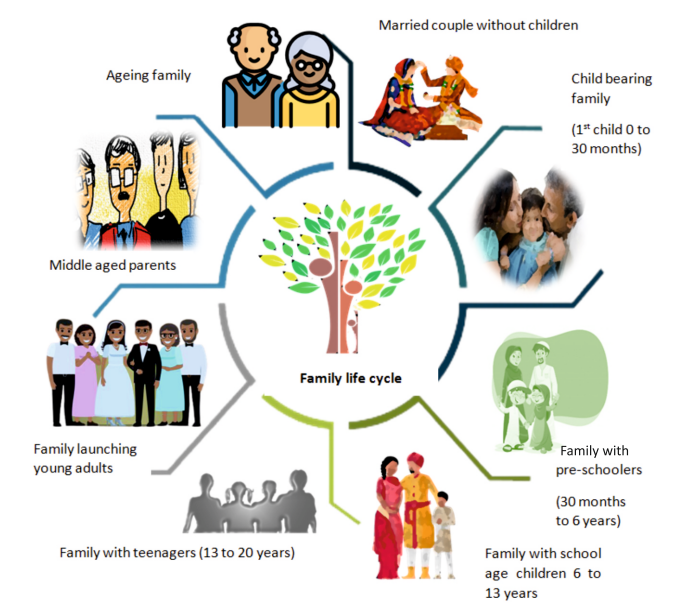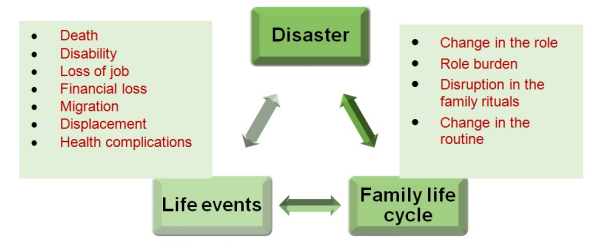Life Events, Family Life Cycle and Disaster
Life Events, Family Life Cycle and Disaster
Stressful life events
Life events are significant events in a persons' life. They can be normative and nonnormative in nature. Normative life events are foreseeable or predictable and take place in every individual's life, e.g., joining or leaving school, entering career or family life etc. Non-normative events are mostly unexpected (disasters, accidents, operation).
Life events can be;
- Desirable (Getting compensation promptly, moving to another place due to job) or undesirable (Loss of life or house or being shifted to a temporary shelter)
- Expected (Getting relief materials or welfare measures) or unexpected (Losing job, being a victim of accident, death)
- Entry (Birth, getting a new job, marriage) or exit (Death, getting terminated, facing destruction)
- Personal (Loss of family members, loss of personal property) or impersonal (Destruction to environment, damage to public property)
Stressful life events can impact the physical and mental health of individuals. Negative life events that happen before or after a disaster can be an indicator for predicting mental health problems. Understanding the life events help in establishing mental health monitory systems wherein persons with significant life events can be followed up closely. This would ease early identification and prompt treatment. Bereavement followed by loss of loved ones due to disaster is one of the most significant contributors to distress out of all the life events.
All individuals have significant events in their lives and the individual's coping abilities and resources help in reducing the effect of the life event. Disaster situations being unprecedented, increases the severity of life events in the individual. People loss their loved ones and property. Disaster situations create changes in the persons' roles and responsibilities. Moreover, the individuals suffer serious loss of support systems and resources. The support systems and resources that acted as buffering units prior to disaster from developing adverse mental health outcomes are now absent or diminished. This disturbs the individual's coping and eventually, his/her well-being gets affected. Hence, it is essential to look after the psychosocial and mental health needs of such individuals who have significant life events with the walk of disaster. Disaster makes people vulnerable and multiplies vulnerability among people who are already vulnerable. Lack of support and resources, subsequent to disaster impacts the coping of survivors resulting in higher distress. The life events also influence the life cycle, roles, responsibilities and rituals of the family. Disaster situations disrupt the family life cycle that induces distress among disaster survivors. The change in the family environment subjected by disaster affects the functioning of the individual, family and the community.
Family life cycle
Family is a recognized social group that nourishes emotional connection within the members and serves as one of the fundamental units of society. As individuals in the family grow, at every stage (a period in the life of a family) of development there is a set of roles and responsibilities (developmental tasks) expected from every member in the family. Each stage of family life involves natural changes, challenges and demands. Typical family life cycle of an individual is shown in the figure below;

Impact of Disaster in the Family Cycle
As already mentioned, every stage in the family life cycle has its own expectations and concerns. When expectations and concerns in one stage is not fulfilled, it gets carried over to the further stages. Failure to deal with the stressors and demands of one stage would add stressors to the following stages. Disaster situation adds stress to the family life cycle and impacts the family balance.
Disaster brings major impact to family life in terms of the person losing his/her spouse, children, parents or at times the entire family. Loss of livelihood, loss of employment opportunities and loss of habitat bring immense distress to the survivor. Loss of family members drives incomparable distress. Family systems get disturbed and the role expectation gets increased. When nominal or functional leaders of the family die in disasters, change in leadership takes place. Calamity results in poor adaptive patterns in the family especially poor problem solving and coping strategies.
Disaster uproots the family from the familiar neighborhood and the primary social support gets affected. Role change, multiplicity of roles, role reversals take place in the structure of the family when there is a death in the family. For instance, if the father and mother of the family are dead in a disaster, the grandparents need to take up the parent's role, if the father is dead, mother has to become the functional leader in dispensing both the instrumental (money, food, other essentials) and expressive (love, care, affection) roles leading to excessive burden due to multiplicity of roles. All these difficulties, change the routine of the family life and members in the family become vulnerable to multiple psychosocial issues.

Mental health complications are high when the family is left without any resources, adaptive coping capacities and inadequate support. It is essential for caregivers to look in to the needs of disaster survivors who lost balance in their family life cycle. Appropriate individual, family and community based psychosocial interventions would help in minimizing mental health problems among survivors whose family life cycle flow is disrupted.
Last Modified : 11/24/2023
This topic provides information about Internationa...
This topic covers the information about Policies a...
This topic covers the information about National D...
This topic provides information about Emergency He...
